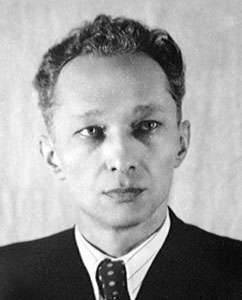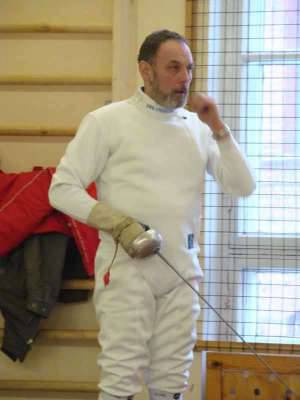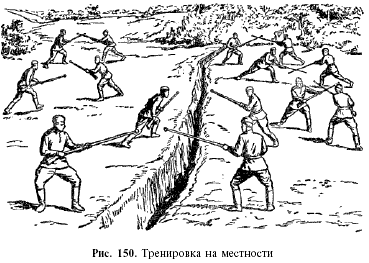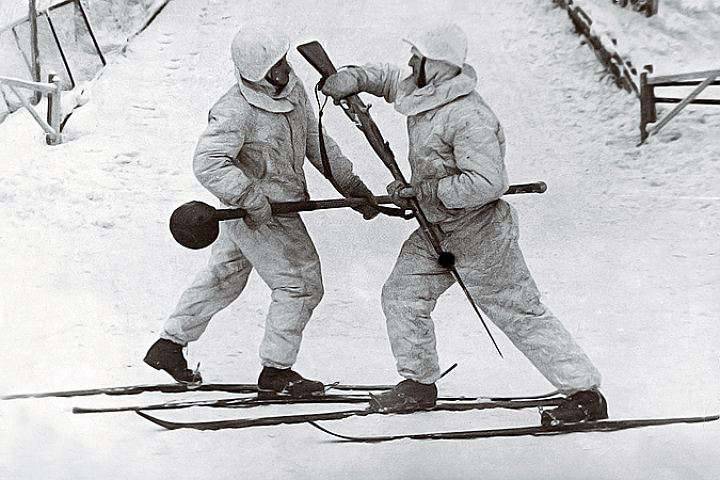Training bayonet at K.T. Bun
 Konstantin Trofimovich Bulochko is one of the founders and central figures of the Soviet hand-to-hand combat. Here are his official regalia: Honored Coach of the USSR, multiple champion of the USSR, Candidate of Pedagogical Sciences, Professor GDOIFK them. PF Lesgaft, founder of the Leningrad school of fencing. Honored Master of Sports, judge of the All-Union category. We talked with one of the students of K. Bulochko, Andrei Savich, trying to reveal more the method of teaching the master and his personality.
Konstantin Trofimovich Bulochko is one of the founders and central figures of the Soviet hand-to-hand combat. Here are his official regalia: Honored Coach of the USSR, multiple champion of the USSR, Candidate of Pedagogical Sciences, Professor GDOIFK them. PF Lesgaft, founder of the Leningrad school of fencing. Honored Master of Sports, judge of the All-Union category. We talked with one of the students of K. Bulochko, Andrei Savich, trying to reveal more the method of teaching the master and his personality. 1. Introduce youreself.
- I'm a swordsman. View weapons - sword. It began, however, with modern pentathlon, when it was still a good sport, and not adapted for a TV show with a lot of conventions. Master of Sports in pentathlon, master of sports in fencing. Executed in 1974 and 1979 respectively. The leader of the pentathlon was a man of legend - Alexander Alekseevich Tarasov, Olympic champion 1956 of the year (Melbourne). Leonid Lvovich Florin led our fencing. Rapierist, besides, left-handed ... But Konstantin Azhitsky taught me to understand correctly what fencing is, and with what they eat it. This was already the time of my student life in Lesgaft. Long. As for KT, Bun - he was the head of the department and led us all 4 year of study. The saber course, then (at its discretion, because it is not provided in the curriculum) - a bayonet. Well, and a lot of methodological lessons about coaching subtleties. Well, and now I’m getting a little bit worse for veterans.
 2. Did Buloch teach you his hand-to-hand combat? At least to some extent. If yes, please describe how the training took place.
2. Did Buloch teach you his hand-to-hand combat? At least to some extent. If yes, please describe how the training took place.- No, he did not teach anyone to fight hand to hand. For obvious reasons. Those were the times when everyone involved in boxing, judo or sambo gave a “no-use subscription”, the violation of which was very expensive. There were precedents with very real deadlines. But this is another story.
Of all that Bulochko knew and knew how to do outside fencing with a saber and a rapier, for some reason he decided to hang out on our group completely, and during the semester we drove for a bayonet battle. With elastic bayonet, of course. There was one horrible snob in the group, a champion of Leningrad for the saber Zakhar Ioffe, who was extremely annoyed by this. True, after Konstantin Trofimovich clearly showed him that he would have a two times higher impact speed in his then 67 years, he preferred to keep quiet. Training, respectively, took place in protective gear (mask, gloves, bib), but the shots were quite real. A flexible bayonet, for all its elasticity, will be harder than a rapier. And the butt hit Trofimych recommended to bring, though not to injury, but so that you and the opponent felt the blow. That is, work in contact, which I would call intermediate between light and medium. Yes, and from the safety equipment - the sink, of course, since the counter-butts to the groin area also had counter-attacks in the diet.
But in practice I later had to encounter something in the army. During the passage of the KMB, we had a sergeant who had completed military intelligence training. He also conducted classes in bayonet fighting. Ridiculous. They were taught three tricks: "long if", "short if", "butt hit." Mustache. Alles Kaput. He did not have the slightest idea of such things as counter-injection with evasion or opposition, or about defending himself. I was very surprised when I dropped it several times.
I saw the author’s copy of the Scout Training Course at Bulochka at home when I entered the department as a teacher and came to him for an interview. He then lived on Kuznetsovskaya Street, near Moscow Victory Park, and preferred to conduct interviews in an informal setting, so to speak. For some reason, I only remember that this book was dated 1943 for the year, and that it was called the “Hand-to-Hand Fighting Manual for Military Intelligence”. Although I may be wrong - it was not yesterday, not even the day before yesterday. Trofimich frankly boasted of this book then, and said that, in general, this copy is the only surviving and generally rare rarity. It struck me how elaborately everything was worked out there: both for you fighting techniques on the parapet, and in the trench, and in the dugout, and in the bush, and in the forest ... Automatic, sapper shovel, knife. Then I saw a textbook on hand-to-hand combat for the military institute of physical education, 1973, the year of publication, perhaps, pallor is incomparable.
3. Very interesting. That is, this is not the book on the integrated training of the scout, which is on the web? Namely, and only in hand-to-hand combat? By the way, I want to note that bayonet fighting is a part of hand-to-hand combat to the full.
- Of course it is. Variety. And about the book - yes, I remember something else. But for sure I can’t be sure - let me remind you, somehow, at least 40 years have passed.
4. What did you do besides fencing (bayonet fighting)? From martial arts, martial arts, etc. What influenced you the most?
- A little karate, a little Taijiquan. But this is so, flimsy health support for. According to the principle "... we all learned a little, something, and somehow." What more influenced? Probably all the same Tai Chi. But not in the sense of combat use, but in the sense of restoring health. It turned out to be a wonderful thing in the 1986 year, when I was recovering from a serious injury from the shooting (I once had a chance a few years, just before that injury), and when I got out of a stroke 3,5 a year ago. The hospital staff was very surprised when I started “24 forms” to remember on the 2 day after transferring from reanimation to the ward. Very contributed, I want to see.
5. It seems that the section K.T. Bun was a kind of forge for shooting films at the Leningrad film studio. Odin V.Ya. Balon is worth something (de Jussacque in the Three Musketeers and Jacques in the Midshipmen). What films did you take part in?
- Well, let's say, I would not hesitate to call her a stunty smithy. The stuntmen were more fighters: sambo wrestlers, judo wrestlers. The same ancestor of the Lenfilm cascade Massarsky is a sambist. Gymnasts and decathletes if work was required at height and falling with it. Autotunts, horse tricks - a separate song. But, by the way, about the same Balon: everything would be fine, and the texture is excellent, but in his cinema fencing you can immediately see the sports rapier school. By the way, do you remember the fencing scene in the film "The Tale About How Peter Arap Married"? There, in this scene, a good half of the USSR national team frolicked as extras. And Yury Chizh put fencing to Vysotsky himself, there was such a very strong foil fighter. By the way, I myself was studing then under the direction of Nikolai Vashchilin, head of the department of physical education of the St. Petersburg Theater Institute. Also a judoka. As for the Bun itself - all the same fencing in films is scenic, and there are very different laws. And hand to hand combat too. From reality, all this is much further than the Decembrists from the people. The spectator must see pauses in the battle, otherwise he simply will not accept what is happening on the screen (by the way, for the same reason so few outsiders at fencing competitions are too fast for an untrained eye). And in a real battle, what can be theatrical pauses? You can, of course, try, but you will go to greet the archangels right there. Therefore, stage fencing Trofimich is not something that he did not like, but ... Although he told about his participation in the production of mass fencing scenes in God forbid memory, “Bogdan Khmelnitsky”. He said that a bunch of professional sabers were overtaken there, and when he saw the purely sports fencing of the Ukrainian Cossacks at the rehearsal, they were standing, moving, and flashing attacks, he laughed for a long time, and then he began to redo everything. On the screen, such sports fencing would indeed look ridiculous.
I managed to play in three films. The movie "Tarantula" ("Lentelefilm") - there is a manuscript. But this is not too much. And in very-very cold water I had to jump. "Peter the Great". It was serious. Americans, six episodes, directed by M. Chomsky, a bunch of stars. We worked at the Battle of Poltava. It was there that they frolicked with a group bayonet battle. By the way, some bayonet techniques helped set. Our leaders in the bayonet were not very. Well, I finished everything in the Kazakh film “Triple Jump“ Panthers ”. Initially, the fight with the participation of the main character took place on a pedestrian bridge over the railway, and they threw me out of it. It turned out so badly (the foot slipped at the wrong time) that I came to St. Petersburg in a condition suitable only for disassembly for parts. And the episode, moreover, had to be completely re-shot. The year was recovering, some four were either fractures, or five. Apart from closed head injury and a couple more charms with complications. Well, then it went a completely different story. Something like this.
6. By the way, were there group battles with bayonets?
- The hall was rather small, so there were no such group battles. Group exercises to work out techniques in pairs only. With the change of partners, of course. They are in sports fencing, which is practically the same in the bayonet.

7. What shells and simulators used in training bayonet combat? The same as in his books? See photo
“Oh, where do such simulators come from in Lesgaft?” I studied at 1971-76, and the last official championship of the USSR was held in 1956, or something ... No, only ordinary fencing stuffed animals were used.

8. Did K.T. Anything interesting about the war, about melee? Surely his students shared their impressions after the war. At least, it is precisely known that the information was collected.
- About the war - no, and about hand-to-hand fighting, too. Something more about fencing. The only thing - he had a favorite story, as he traveled the penal battalion to pacify. I will not literally remember him now, of course, but the point is that somewhere in the outskirts of Moscow, riots broke out in the emerging penal battalion, and he was sent there to bring order. On arrival, upon arrival, some thug ambal of the "main", which Bulochko, without going into long discussions, laid with one punch. He looked at the same time two times smaller than this mound. After that, the riots somehow quickly subsided, and they began to seriously respect him. In his own words (this is the final phrase): “I left — they called my father!”
9. What was KT? Describe him, his character, his pedagogical methods.
- He was an aristocrat. It is with a capital letter. And not in the sense of external manners, although with all the students he spoke strictly on “you”, but in the sense of the highest responsibility for everything he did. He practically never raised his voices, he loved to joke. At the very first specialization classes, he clearly formulated: “You did not come here to learn fencing. To do this, you have coaches, and you already know a lot. You came here to LEARN TO LEARN fencing. And this is much more complicated art. ” His patience, on the one hand, was truly titanic. On the other - a number of things he could not tolerate, and knew how to make so that about relapses and thoughts did not arise. A simple example: the bun on the spirit did not tolerate, when for a handshake, they gave a hand with a lethargic "boat." He himself always gave an open hand, and his handshake was by no means weak. By the way, with all the communication on "you", he always greet students with his hand. And Zakhar Ioffe, who was already mentioned, just had exactly that hated Bun. Once, in the corridor, the Bunny meets Joffe, who gives a hand with a “boat,” Bun looking at him in bewilderment: “Ioffe, you are no longer a swordsman, are you? The swordsman must give a hand like this! ”Joffe's heart-rending cry was heard on the next floor.
From the very first lessons, the bun put another important thing in the head - if you received a beautiful injection from an opponent from whom you didn’t even have a chance to defend yourself, take off the mask and thank him sincerely: no coach will teach you better than such an opponent .
He drove us to the seventh sweat and stop breathing over the technique and manner of action of the coach in the individual lesson, which, as we know, is the main form of training in fencing. And I noticed all the mistakes, in my opinion, even being back to you. And everything in his classes was very organically layered on each other: “Oh, here you have a mistake ... let's do it again. Fine. But now look - the weapon is better in relation to the student to keep five degrees lower. Perfectly. And now ... "And so 90 minutes without a break. Sometimes they crawled out. Steeper than the most intense of their own training. But it all got into the cortex. No wonder back in the 1950-s many eminent foreign fencers considered it an honor to get a lesson from Trofimich.
10. How much roughly technical actions in bayonet combat? How did you learn to hold a gun? How to paddle kayaks, or in a different way?
- Well, it's hard to say. It also depends on their own intuitive improvisations. I somehow came across a pre-revolutionary textbook on bayonet fighting - there, I remember, there were a dozen of these technical actions, three or four, if not more. How to paddle? Well no. The paddle is usually held with two hands on top, if I am not mistaken ... The rifle is one hand approximately in the middle of the forend below, the other between the breech and the butt is on top.
11. Do you agree with the statement that a fight without weapons comes from a fight with weapons? Roughly speaking, a direct blow from the injection. Or hit the "fist edge" from hitting a mace / ax? And does the direction of RB Bun? That is, has he developed his own hand-to-hand combat based on fencing in your opinion?
- I completely agree. Strictly speaking, the first cold weapon was an elementary cudgel, or stick. All strikes such as swing, hook, or hit with a "hammer" - they all come from punches that are better classified as chopping. The same with the defenses. Simple parallel: take karate. The “Gedan-Barai” block - along the trajectory is typical 2-i protection in fencing. Age-uke - 5-I saber protection. Ude-uke and uchi-uke - 3-i saber protection. And so on, there are many parallels. Yes, I believe that the fencing school greatly contributed to the direction of the Republic of Belarus, which was developed by Bun. And, rather, fencing is exactly saber, not rapier and not sword, although in the last two types of parallels with a bayonet is more than enough. However, there is a significant nuance: the fencing, which Bulochko was engaged in, was still sporting. That is, the actions of the strike / injection are performed ONLY by one armed hand (we are not talking about movements now). Everyone is involved in hand-to-hand combat - both arms, both legs, and even teeth with which to bite. Therefore, I would be careful not to say that Bulochko developed his system of training in the Republic of Belarus only on the basis of fencing. It contributed - yes, of course. But it was hardly the basis of the foundations.
***
List of main publications Bun:
Thesis (for the degree of candidate of pedagogical sciences):
• Physical training of the scout [text]: Dis. … cand. ped. Sciences (in physical culture) / GDOIFK im. P. F. Lesgaft. - L, 1945. - 327 p.
Proceedings
• "Preparing a fighter for hand-to-hand combat" / Bulochko K. T. // Teoriya i praktika nat. culture. - 1940. - T. VI. - N 8. - S. 27-30.
• "Hand-to-hand combat and fencing" / Bulochko K. T., Lukichev M. V. - M.; L.: FiS, 1940. - 186 p.: ill.
• "Fencing and hand-to-hand combat in a children's sports school" / Bulochko K. T. // Teoriya i praktika nat. culture. - 1940. - T. VI. - N 2-3. - S. 34-41.
• "Collection of notes on training for hand-to-hand combat" / Comp. lieutenant K. T. Bulochko. - Kronstadt: B. I., b. g. - 20 s.
• "Fencing and hand-to-hand combat": [Textbook. for Institute of Physical Culture] / [Ed. K. T. Bulochko and others]. — M.; L.: FiS, 1940. - 354 p.: ill.
• "Hand-to-hand combat and fencing" / Bulochko K. T., Lukichev M. V. - M.; L.: FiS, 1940. - 186 p.: ill.
• "Teaching hand-to-hand combat" /K. T. Bulochko M.: Physical culture and sport, 1942 (2nd ed.), 86 pp.
• "Physical training of a scout". /TO. T. Bulochko Military publishing house of NPO. Moscow (1945)
• "Training young men in hand-to-hand combat" /K. T. Bulochko a guide for teachers - M .: FiS, 1945. - 79 p.: ill.
• "Advice to the coach on the methodology of volitional training of a fencer" / Bulochko K. T. // Teoriya i praktika nat. culture. - 1964. - N 11. - S. 70-72.
• "Fencing": A textbook for institutes of physical culture / Ed. K. T. Bulochko. - M .: Physical culture and sport, 1967. - 431s. : ill.
• "Means and methods of conducting exercises for the development of physical qualities and motor skills": Method. instructions for students of specialization / Bulochko K. T., Bulochko D. K.; GDOIFK. - L .: B.I., 1979. - 85 p.
• "Barriers to Aging" / Konstantin Trofimovich Bulochko, Lyudmila Konstantinovna Bulochko. - Minsk: Polymya, 1987. - 60, [3] p. - (For health and longevity). — Bibliography: p. 62.
Information